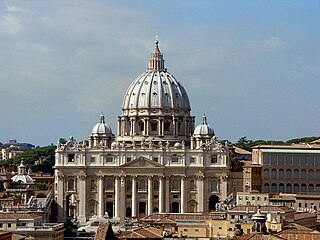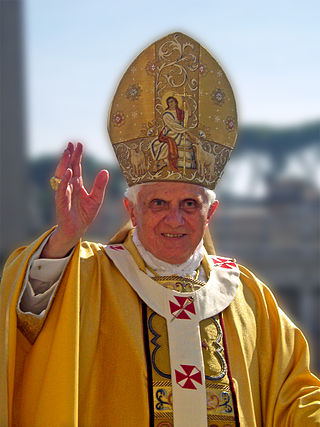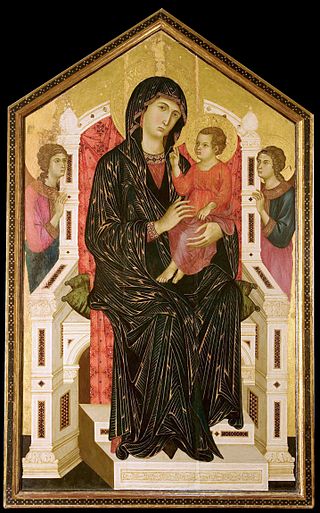
Irenaeus was a Greek bishop noted for his role in guiding and expanding Christian communities in the southern regions of present-day France and, more widely, for the development of Christian theology by combating heterodox or Gnostic interpretations of Scripture as heresy and defining proto-orthodoxy. Originating from Smyrna, he had seen and heard the preaching of Polycarp, who in turn was said to have heard John the Evangelist, and thus was the last-known living connection with the Apostles.

The Second Ecumenical Council of the Vatican, commonly known as the Second Vatican Council, or Vatican II, was the 21st ecumenical council of the Catholic Church. The council met in Saint Peter's Basilica in Vatican City for four periods, each lasting between 8 and 12 weeks, in the autumn of each of the four years 1962 to 1965. Preparation for the council took three years, from the summer of 1959 to the autumn of 1962. The council was opened on 11 October 1962 by John XXIII, and was closed on 8 December 1965 by Paul VI.

Dominus Iesus is a declaration by the Congregation for the Doctrine of the Faith, approved in a plenary meeting of the Congregation and signed by its then prefect, Joseph Cardinal Ratzinger, and its then-secretary, Archbishop Tarcisio Cardinal Bertone. The declaration was approved by Pope John Paul II and was published on August 6, 2000.
Lumen gentium, the Dogmatic Constitution on the Church, is one of the principal documents of the Second Vatican Council. This dogmatic constitution was promulgated by Pope Paul VI on 21 November 1964, following approval by the assembled bishops by a vote of 2,151 to 5. As is customary with significant Roman Catholic Church documents, it is known by its incipit, "Lumen gentium", Latin for "Light of the Nations".
Inter mirifica, subtitled "Decree on the Media of Social Communication", is one of the Second Vatican Council's 16 magisterial documents.
The following outline is provided as an overview of and topical guide to Christian theology:

In Christianity, salvation is the saving of human beings from sin and its consequences—which include death and separation from God—by Christ's death and resurrection, and the justification entailed by this salvation.
Miaphysitism is the Christological doctrine that holds Jesus, the "Incarnate Word, is fully divine and fully human, in one 'nature' (physis)." It is a position held by the Oriental Orthodox Churches and differs from the Chalcedonian position that Jesus is one "person" in two "natures", a divine nature and a human nature (Dyophysitism).

The theology of Pope Benedict XVI, as promulgated during his pontificate, consists mainly of three encyclical letters on love (2005), hope (2007), and "charity in truth" (2009), as well as apostolic documents and various speeches and interviews. Pope Benedict XVI's theology underwent developments over the years, many of which were characterized by his leadership position in the Congregation for the Doctrine of the Faith, which is entrusted with preserving the Catholic faith in its entirety.
Ut unum sint is an encyclical by Pope John Paul II of 25 May 1995. It was one of 14 encyclicals issued by John Paul II. Cardinal Georges Cottier, Theologian emeritus of the Pontifical Household, was influential in drafting the encyclical.
Centesimus annus is an encyclical which was written by Pope John Paul II in 1991 on the hundredth anniversary of Rerum novarum, an encyclical issued by Pope Leo XIII in 1891. It is part of a larger body of writings, known as Catholic social teaching, which trace their origin to Rerum novarum and aim to relate the teachings of Jesus to the industrial age.
Veritatis splendor is an encyclical by Pope John Paul II. It expresses the position of the Catholic Church regarding fundamentals of the Church's role in moral teaching. The encyclical is one of the most comprehensive and philosophical teachings of moral theology in the Catholic tradition. It was promulgated on 6 August 1993. Cardinal Georges Cottier was influential in drafting the encyclical, as was Servais-Théodore Pinckaers, a professor of moral theology at the University of Fribourg.

James Alberione, SSP, was an Italian Catholic priest, and the founder of the Society of St. Paul, of the Daughters of St. Paul, of the Pious Disciples of the Divine Master, of the Sisters of Jesus the Good Shepherd, of the Sisters of Mary Queen of the Apostles, and other religious institutes, which form the Pauline Family. The first two groups are best known for promoting the Catholic faith through various forms of modern media.

Pontifical University of the Holy Cross is a Roman Catholic university under the Curial Congregation for Catholic Education, now entrusted to the Prelature of the Holy Cross and Opus Dei, or more commonly called Opus Dei. It was started in 1984 by Opus Dei, with the aim of offering the universal church an effective instrument for formation and research.
The Pontifical Council for Social Communications was a dicastery of the Roman Curia that was suppressed in March 2016 and merged into the Secretariat for Communications.

The theology of Pope Pius XII is reflected in his forty-one encyclicals, as well as speeches and nearly 1000 messages, during his almost 20-year pontificate. The encyclicals Mystici corporis and Mediator Dei advanced the understanding of membership and participation in the Catholic Church. The encyclical Divino afflante Spiritu began opening the door to historical-critical biblical studies. But his magisterium was far larger and is difficult to summarize. In numerous speeches Catholic teaching is related to various aspects of life, education, medicine, politics, war and peace, the life of saints, Mary, the mother of God, things eternal and temporal.

The history of Catholic Mariology traces theological developments and views regarding Mary from the early Church to the 21st century. Mariology is a mainly Catholic ecclesiological study within theology, which centers on the relation of Mary, the Mother of God, and the Church. Theologically, it not only deals with her life but with her veneration in life and prayer, in art, music, and architecture, from ancient Christianity to modern times.

Mariological papal documents have been a major force that has shaped Roman Catholic Mariology over the centuries. Mariology is developed by theologians on the basis not only of Scripture and Tradition but also of the sensus fidei of the faithful as a whole, "from the bishops to the last of the faithful", and papal documents have recorded those developments, defining Marian dogmas, spreading doctrines and encouraging devotions within the Catholic Church.
The Pontifical Athenaeum Regina Apostolorum is an educational institute of the Catholic Church in Rome.

Catholic ecclesiology is the theological study of the Catholic Church, its nature, organization and its "distinctive place in the economy of salvation through Christ." Such study shows a progressive development over time being further described in revelation or in philosophy. Here the focus is on the time leading into and since the Second Vatican Council (1962–1965).











